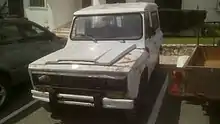Portaro
PORTARO was the name of a popular Portuguese 4WD offroad utility vehicle which was based on the earlier Romanian original ARO 24 Series 4X4 model produced under license in Portugal. PORTARO 4WD models were made between 1975 until 1995. It was almost like the famous British Landrover 4X4 and was the most successful Portuguese vehicle ever, before the arrival of the later UMM 4x4. The PORTARO name was an acronym of PORT for Portugal + ARO the Romanian main producer of offroad vehicles.
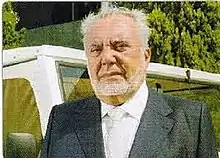

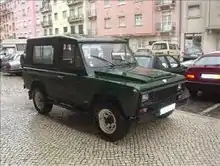
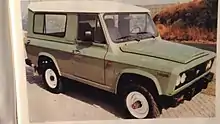
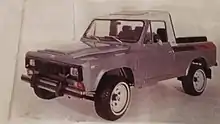
History
The Portaro was a popular cross-country 4X4 vehicle manufactured from imported parts in CKD form destined for assembling them in Portugal starting in 1975 by the entrepreneur and industrialist man Hipólito Pires with help from a business partner José Megre. The Portaro was a modern version derived from the original ARO 240 4WD Series originally from the 1970s.
The PORTARO 4X4 first appeared in 1975 and came in two main versions: The PORTARO 4X4, an offroad utility jeep, and later in 1977 the PORTARO Campina 4X4 a pick up truck version both were similar to the worldwide known British Landrover 4WD model.
In the early 1980s, three modified PORTARO 4WD models even won the Paris-Dakar Offroad Pharaoh Rallye driven by French and Portuguese teams, all with Volvo petrol engines, plus two Diesel units: A Campina 320 and a Campina Super 350 for the behind-the-scenes team crew and staff. The standard output PORTARO model production was an estimated average of 2000 units made a year.
Later original PORTARO 4X4 vehicles were also available and imported to the UK during the 1970s and 1980s by the entrepreneur Geoff Edmunds who owned a company called PAMPAS VEHICLES LIMITED based at Caerleon, in Wales. His company offered an original model range of up to ten different versions all sold under the name of PORTARO Pampas 4WD 260 Series which were factory-built already with RHD and Power Steering, powered by Daihatsu Diesel 2530cc engines as were the Pampas 260 Van 4WD and also the Pampas 260 4WD Pickup these models were also available with a choice of the optional Canvastop or Metaltop roofs. These Portuguese vehicles were complemented by another British importer of Romanian vehicles called County Vehicles Limited at Silverton in Devon who specialized in ARO, DACIA, ROCAR, TV and other East European car brands models to sell them all in the UK from the 1970s on.
Beginning and development
PORTARO started in the 1970s when Hipólito Pires with José Megre got together as industrial partners when they decided to start creating a motor vehicle assembly production line under the name "Projecto Portaro" when large loans of Portuguese State funds were granted to start this new joint-venture automobile plan. Once the cashflow was assured and delivered so did the brand name PORTARO. Initially the well known GV-Garagem Vitoria the one of the domestic main Motor Car Importers were to collect and receive the ARO vehicles from Romania at the docks in CKD form and transported them for their final production facility to Setubal where several 4X4 prototype models were built soon that year in 1975 all with different running gear fitted for testing them in all kinds of environment and treatment.
Soon enough Mr Pires went to Japan in search for a wellknown manufacturer and supplier of modern running gear but only Daihatsu Motor Company of Osaka in Japan who agreed to help him out and negotiations started. Not so long the famous Brandname of PORTARO 4WD vehicles were launched fairly quickly after their vehicles were involved in offroad trials and other successful evaluations, motor vehicle production was officially started by the then recently formed SEMAL company. The name was an acronym of Sociedade Electro-Mecanica de Automoveis Limitada which were originally a former large Military Plant with ideal premises suitable enough and quickly acquired by both business partners Mr Megre and Mr Pires for vehicle production located in Setubal a huge industrial town 36 km South of Lisbon. Here is where all PORTARO 4WD vehicles were assembled for mass production from the 1970s until the 1980s.
SEMAL also had at least one stockparts warehouse depot in Lisbon where its now-subsidiary Garagem Vitória company stocked there large amounts of original ARO parts and modern Daihatsu Diesel mechanicals ready for them to use as a resource that GV were delivering and organizing for SEMAL. Meanwhile by the early 1980s with several interesting large sales obtained, another entirely new model arrived this was the larger TAGUS 2500 4X4 another model range that was going to be assembled and using the same Daihatsu original running gear. Decision was made by Mr Megre and Mr Pires for GV to actually bring over the original Romanian-made ROCAR TV 4X4 offroad model that could also be assembled in Portugal by SEMAL alongside their own new PORTARO 4WD already current original model range.
Before the PORTARO offroad lifespan really started in the 1970s the company GV-Garagem Vitória went to Switzerland for the 1978 Geneva International Motor Show who actually brought and displayed there 2 completely different vehicles the first one a brand new red PORTARO Celta 260 TURBO 4X4 which was a hardtop model fitted with a Daihatsu 2530cc TurboDiesel engine, and a second model was a canvas-roofed white model 'PORTARO 240 4X4'2500 Diesel. In the case of the first model it was the first time ever that a Portuguese automobile manufacturer was involved at the European International Showstand as was the first time ever for a Portuguese car brand name powered with TD TURBODIESEL engine being displayed brought over there at the famous 1978 Geneva Motor Show.
Meanwhile during 1982 GV (who now was part of the PORTARO trademarque and its assets) firm bought the entire SEMAL assembling factory division and this whole operation was going to be trading as GV-SEMAL becoming a very successful manufacturer of every PORTARO model and the entire model range was revamped with other new models being tested and tried now powered by the optional Volvo petrol running gear while by 1984 other 4WD model were made with GM mechanicals but these were soon dropped. Production of the very rare model yet interesting TAGUS GV 2500 4WD utility offroad vehicle was by now dropped due to its slow sales while Portaro 4WD models were enjoying a remarkable common sight everywhere were catching up with a reputed 2000 PORTARO offroad vehicles that were sold year which allowed parent company GV to expand their model line-up with improved new model range now assembling and offering relaunching the then updated PORTARO Campina 4WD models.
After reaching large sales GV-SEMAL updated all its PORTARO 4×4 models for 1985. Soon there was an unusual choice of up to 17 alternative PORTARO 4×4 models were available at the time. For a short time in the 1980s, ARO 4WD models were also assembled in Spain and production was supervised by ENASA quite a large motorvehicle company who handled their distribution network and managed sales of these new vehicles locally sold under the HISPARO brand name but closely resembling the Santana Landrover 4X4 models again using a variety of domestic but very different running gear sourced from other local manufacturers.
GV-SEMAL meanwhile were now developing new models for the 1980s who also brought a wider choice of modern new DAIHATSU Diesel or the new VOLVO petrol engines now with 5 speed manual transmissions. That decade also saw the arrival of the entirely new industrial PORTARO Campina 4WD offroad models with restyled cabs, with short & long chassis versions, very unusual 3 seats inside with up to ten alternative Campina versions were available these were powered by a choice of the Daihatsu Diesel DG 2800 or DG 2530 running gear, taken straight from the popular 1980s DAIHATSU Rocky, Taft and Wildcat 4WD offroad model ranges of the same decade, all of these Japanese classic 4WD models were very too popular in the UK, Asia, Australia and other parts of Europe.
However and due to a number of reasons that GV-SEMAL were faced with market competition and the huge increase in the growing Portuguese New 4WD Offroad Model Market, GV could no longer keep up with the Portaro marque and were forced to reduce their original PORTARO 4WD model range and sold all the offroad production rights in the 1980s to another independent company where production was moved further Northeast to the larger FMAT factory at Tramagal near the town of Abrantes in the Santarém district. Once there at the FMAT motor vehicle plant production was reinstated and the PORTARO 4X4 brand name within a month or so returned but with a much-reduced model range being produced once again under an all-new ownership. Only this time none of the more powerful PORTARO 4X4 Volvo-petrol engined versions were offered as these sold poorly. Today the same FMAT factory is now much larger and are now producing the current ISUZU and MITSUBISHI medium to large-sized lorries and vans, all intended for export to France, Spain, and North Africa automobile markets. Currently, the FMAT company are still one of the few large vehicle manufacturers left here in Portugal.
FMAT from the 1980s onwards produced a small model range of different PORTARO 4×4 original vehicles. The first model was an updated version of the very much improved and restyled PORTARO 280 DCM nineseater jeep and the rugged useful 280L Campina 4X4 Pickup truck models both using all new modern Daihatsu 2800 Diesel mechanicals and several extras could be ordered during their production. Then by the early 1990s another model was launched the rare 1990s PORTARO FMAT 250 ID 4X4 2500 which was a revamped PORTARO 4X4 using as many parts as possible but now powered by a much improved FORD TRANSIT 2500 Diesel/2500 Turbodiesel running gear and stronger chassis, with new current ARO 4WD axles, new parts like four round headlights, inside a new interior was redeveloped too and there were leather seats for 2-9 passengers, carried more extras and equipment with several other items the customer/owner could order for his new PORTARO 4X4. Unfortunately by the 1990s, this latest model proved less successful than hoped for and by 1995 the FMAT company encountered some unexpected manufacturing problems and the Portaro production was gradually halted.
Normal PORTARO 4X4 production suddenly ended by 1995 when the so-called RPMC Motor Vehicle Project deal (Romanian-Portuguese Manufacturing Contract) had expired and no more ARO genuine parts arrived to the Lisbon docks to collect. The FMAT factory owners claimed that the Portuguese State funds were no longer supporting them to actually keep making these vehicles, with severe issues about some failures to renegotiate again with ARO in Romania who were complaining and insisted that the Portuguese authorities had deserted them and ARO company were no longer being paid much for their ordered CKD components, resulting in case of an apparent massive corruption during the whole process to no avail.
All of these problems forced FMAT to slow down new PORTARO 4X4 offroad vehicle production gradually and the last 1000 or made new PORTARO 4X4 models were manufactured there were actually built using most of the leftover parts with many other spares gathered that FMAT purchased before relaunching the brand name in 1990 that were still kept unused by the original PORTARO previous owner & importer GV-SEMAL based in Lisbon. Sadly the once very successful PORTARO brand name's very long career then came to a rather abrupt end making it an historic Portuguese marque that disappeared was erased and gone from that automobile market during the Summer of 1995.
Many PORTARO 4WD vehicles are today preserved regardless of their age and condition but are driveable and many have been restored to perfect state today mostly are Daihatsu Diesel engined. Besides the PORTARO brand name made in Portugal since 1975 it was joined two years later by another Portuguese manufacturer, UMM, another motor company, who also adopted an original 4WD vehicle made in France, under a franchised manufacturing project.
Model range
This is a complete list of all the original GV-SEMAL brand, makers of the TAGUS and the PORTARO Model Range of 4X4 vehicles manufactured 1975-1995 including the models later produced by the FMAT company.
GV SEMAL Tagus Range
(Made 1976 to about 1986 all based on the ROCAR TV 4WD model, some fitted with the Daihatsu Diesel 2530cc TD 96 BHP engine)
- TAGUS GV DIESEL 2500 4X4 Furgão (A Van three-seater model)
- TAGUS GV DIESEL 2500 4X4 Misto (A six-seater combi-van)
- TAGUS GV DIESEL 2500 4x4 Pickup (A three-seater truck)
- TAGUS GV DIESEL 2500 4X4 Ambulance
- TAGUS GV DIESEL 2500 4X4 Chassis Truck
- TAGUS GV DIESEL 2500 4X4 Fire Engine
- TAGUS GV DIESEL 2500 4X4 Military Truck
- TAGUS GV DIESEL 2500 4X4 Minibus
GV SEMAL PORTARO Range
(From 1975 to 1995)
- PORTARO 230PV 4X4 Rally (A light rally racing model used in the famous gruelling 1983 Paris-Dakar Rallye Event quickly became a winner.)
- PORTARO 230PVCM 4X4 Funcar (Same as above but more of a roofless offroad leisure type funcar.)
- PORTARO 230PVP 4X4 Pickup Petrol (Same as above but with factory welded cargobox behind the 3 seater cab.)
- PORTARO 240D Diesel 4X4 (The very first PORTARO offroad jeep with Daihatsu DG30 2530cc diesel engine launched in 1975.)
- PORTARO 240D Diesel 4X4 Pickup (Same as above, it was a 3-seater cab useful pickup truck.)
- PORTARO 240D Diesel 4X4 Furgão (A three-seater basic closed offroad Van model.)
- PORTARO 240D Diesel 4X4 Especial (A forestry work/armytruck model fitted with winch, large tyres and other extras for specialized roles)
- PORTARO 250DGL Diesel (The only Portaro model without 4X4 axles instead has just RWD only, about 500 or so of these were made.)
- PORTARO 250 FMAT ID Diesel 4X4 (The last new known Portaro 4X4 model available for the 1990s with modern Ford Transit mechanicals and parts)
- PORTARO 260D Diesel 4X4 Cabriolet Especial (A Convertible jeep with new engine & new gearbox, and several luxury items.)
- PORTARO 260D Diesel 4X4 Jipe (Same as above with new Daihatsu running gear, new suspension, removable rooftop & parts.)
- PORTARO 260D Diesel 4X4 Pickup (Same as above, a pickup truck model, with new 3 seater cab and new redesigned interior.)
- PORTARO 260DCM Diesel 4X4 Furgão (As above but has a redesigned interior, improved construction and new components.)
- PORTARO 280DCM Diesel 4X4 Jipe (Another new model nine seater now using new Daihatsu 2800cc Diesel engines and other modern parts.)
- PORTARO 280DCM Diesel 4X4 Ambulance (As above but with a new 5 speed gearbox and improved 3 range offroad transfer case.)
- PORTARO 280DCM Diesel 4X4 Furgão (A 3-seater van bodied model powered by modern Daihatsu 2800 mechanicals.)
- PORTARO 280DCM Diesel 4X4 Bombeiros (Popular model to carry firemen and their firefighting equipment of which several hundred were ordered)
- PORTARO CAMPINA 280L Diesel 4X4 Pickup truck (An 1980s new pickup truck fitted with modern Daihatsu Diesel 2785cc running gear )
- PORTARO CAMPINA 320 Diesel 4X4 Pickup truck (Originally made in the late 1970s a very popular model with Daihatsu Diesel 2530cc mechanicals)
- PORTARO CAMPINA 350 Super Diesel 4X4 Pickup truck (A restyled model with new interior, new independent suspension and new longer chassis.)
- PORTARO CELTA 210PT TURBO 4X4 (A kind of a Range Rover 4X4 luxury model and now very rare with Volvo BE2120 Turbocharged petrol car engine.)
- PORTARO CELTA 260 TURBODIESEL 4X4 (Another rare Range Rover type 4X4 luxury jeep powered by Daihatsu Turbo Diesel 2530cc engine.)
- PORTARO CELTA 280DCM Diesel (From the 1990s a regular nine-seater 4X4 model.)
- PORTARO CELTA 280DCM Cabriolet (From the 1990s A Hardtop removable roof Convertible model)
- PORTARO PAMPAS 260D Diesel 4X4 (For Export only with standard RHD for the UK Market)
- PORTARO PAMPAS 260DPU Diesel 4X4 Pickup (For Export only with standard RHD for the UK Market)
- PORTARO JIPE 1984 Diesel 4X4 (Prototype new six-passenger model but never produced)
- PORTARO NATO GVM Diesel 4X4 (Prototype Military new model but never produced)
Gallery
 A 1970s SEMAL TAGUS GV250 4X4 Commercial Offroad Model Range
A 1970s SEMAL TAGUS GV250 4X4 Commercial Offroad Model Range A rare 1970s SEMAL TAGUS GV250 4X4 Diesel Truck in restored condition
A rare 1970s SEMAL TAGUS GV250 4X4 Diesel Truck in restored condition A rare 1970s SEMAL TAGUS GV250 4X4 Truck Diesel awaiting restoration in Portugal
A rare 1970s SEMAL TAGUS GV250 4X4 Truck Diesel awaiting restoration in Portugal A restored pair of PORTARO 350 Campina Super and a 320 Campina Pickup Trucks
A restored pair of PORTARO 350 Campina Super and a 320 Campina Pickup Trucks A 1980s Portaro 240 Van 2500 Diesel 4X4
A 1980s Portaro 240 Van 2500 Diesel 4X4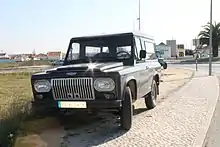 A 1980s Portaro 240 Van 2500 Diesel 4WD
A 1980s Portaro 240 Van 2500 Diesel 4WD
HISPARO
HISPARO Todoterreno 4X4 or the Spanish ARO, another relative
Besides the PORTARO 4X4 utility model range assembled and made in Portugal from Romanian, Japanese and Swedish parts, ARO of Romania also started another derivative based on its own offroad designs although this one appeared much later, this time in Spain. This new model was powered again with foreign mechanicals as this was the easiest method ARO could find to start their new model project another modern offroad vehicle called the HISPARO Todo Terreno 4X4, this new model lasted from the early 1980s to around 1991 the last for the HISPARO offroad production and it was assembled by the ENASA factory at Sagrera in Barcelona where most Pegaso light models were manufactured. These new HISPARO Todoterreno 4X4 models had a strong styling resemblance to the Japanese classic 1981-1983 Datsun Safari Estate 4X4 / Nissan Patrol Long 4WD both names were used for the same offroad utility vehicle.
HISPARO 4X4 Development and Start
Before the new HISPARO 4X4 even existed, Aro of Romania believed it could also produce its own models in Spain, in a similar way the earlier PORTARO model was, so ARO contacted the largest Spanish motor vehicle manufacturer ENASA company based in Barcelona, Madrid and Valladolid to help ARO launch and produce an offroad utility vehicle designed in Romania but made in Spain, under the chosen brandname of HISPARO Todoterreno 4X4 built with modern current EBRO, PEGASO and VIASA running gear and numerous imported Romanian parts in CKD form.
HISPARO 4X4 launch and production
ENASA of Barajas near Madrid agreed to produce the new HISPARO Todoterreno 4X4 as long as they carried most ARO components and main parts, but the Spanish had to find another source for its mechanicals somewhere else and then launch their new HISPARO 4X4 jeeps & pick up models to the Spanish automobile market during the mid-1980s. So ENASA contacted the local VIASA company based in Zaragoza the most experienced Spanish offroad vehicle manufacturer and placed an order for a prototype go-anywhere vehicle complete with running gear fitted and two new different offroad vehicles were delivered to the ENASA factory for a complete evaluation. These were called the ENASA-VIASA EV1 4X4 and the EV2 4X4. Standard HISPARO vehicle production was given the go-ahead.
One of the prototype models was powered by a Perkins Diesel 2700cc 4 cylinder engine and was a 6-seater jeep and the other one had an EBRO-Nissan Diesel 2800c 4 cylinder engine and was a 3-seater pickup truck, both vehicles had 4WD axles, with its own 5 speed manual gearbox and VIASA-JEEP dualrange transfer gearbox for offroad driving and the cars were made in 1984, one of the few road vehicles that VIASA-JEEP made for other firms, after a week evaluation these prototypes became the basis for the then new original HISPARO Todoterreno 4X4. Current HISPARO Todoterreno production models were powered by standard PEGASO TD and PERKINS Diesel 4 cylinder engines, but very soon customers had also the choice of optional EBRO-NISSAN TD or ISUZU TDI modern running gear.
Because ENASA produced mainly heavy-duty vehicles, so it was never designed for light and small vehicles, it was decided to transfer HISPARO 4X4 production to their other smaller ENASA factory at Sagrera in Barcelona where PEGASO light delivery model range were made since 1960, these were mainly pickup trucks, combivans and vans plus the new HISPARO 4X4 model range starting in early 1984. Near them in the same industrial estate, there is also the EBRO MOTOR IBERICA another motorvehicle factory, that makes similar vehicles and it is also a large company, now owned and run by the NISSAN MOTOR CO of Japan.
After the new HISPARO Todoterreno 4X4 models entered the Spanish automobile market of the 1980s, there were already many other makes & models, and most carried the words " Fabricado En Espana" with a wide choice of many other 4WD vehicles available made under these names: AVIA, BARREIROS, EBRO, IASA, IBESA, IPV, LUNA, NAZAR, PEGASO, SANTANA, SAVA, UROVESA and VIASA besides the well known SEAT car company. At the beginning HISPARO sales were reasonably good during the mid-1980s to early 1990 with many of them being acquired and were going to the local Fire Departments, Emergency Services, Police Forces and the Spanish Army to join the other locally made vehicles mostly Pegaso and Santana along with other offroad vehicles but a decent large number of them ended or bought by civilian buyers too as the needed spareparts and engine components all were plentiful.
Unfortunately by 1990 sales were becoming slow because some customers were more interested in longer established offroad makers like EBRO-NISSAN, SANTANA-LANDROVER and VIASA-JEEP that were better known and more popular than other 4WD models, so this soon overtook the HISPARO Todoterreno 4X4 in sales and it was decided that ENASA would cease their production in the early 1990s and ARO soon realized they had to quit exporting components and parts for Spain to keep HISPARO vehicles under production without demand. By the early 1990s the original HISPARO 4X4 lifespan was also short-lived too as the large Italian IVECO Group bought the Spanish ENASA-PEGASO truck business in September 1990 and ENASA was no longer interested in the HISPARO automobile project but assembled around 1800 HISPARO models before this brandname vanished and ENASA itself later merged into IVECO.
HISPARO TODOTERRENO The original model range
Some of the following HISPARO offroad models assembled and produced locally, are noted to have also been fitted with the original ENASA PEGASO Diesel running gear similar to their own PEGASO Sava J-Series Van range at the time in the 1980s
HISPARO 241D 4X4 A Perkins Diesel 2600cc engined 3 seater van model with modified ARO bodyshell.
HISPARO 242D 4X4 A Perkins Diesel 3000cc engined 3 seater van with 3 doors built on a new Pegaso chassis.
HISPARO 243D 4X4 A new Pegaso Diesel 2700cc engined jeep with 6 seats and new interior built with many ARO parts.
HISPARO 244D 4X4 A new Ebro 2800cc TD engined jeep with 9 seats fitted with new suspension and restyled interior.
HISPARO 245D 4X4 A luxury jeep with 9 seats, new interiors on an extended chassis with a Pegaso 2700cc Turbodiesel engine.
HISPARO 241DP 4X4 A new Perkins Diesel 2600cc engined 3 seater 2 door pick up with a standard ARO chassis.
HISPARO 242DP 4X4 A new Isuzu TDI 2800cc engined closed 3 door pick up truck with new longer ARO chassis.
HISPARO 243DP 4X4 A new Ebro Patrol 3000cc Diesel pickup truck with new interiors, allround suspension and 3 seats.
HISPARO 244DP 4X4 A new Ebro 2800cc Turbodiesel crew cab pickup truck model with 4 doors and seats for 6 people.
HISPARO 245DP 4X4 A new Pegaso 3000cc Diesel powered restyled sports/leisure pickup truck 5 door model with 6 seats.
References
PORTARO Two separate Facebook Pages featuring company history, model photos and more details
ACP Automovel Club De Portugal similar to the AA in the UK
Autohoje Motor magazines
Guia Do Automovel Motor magazines
External links
| Wikimedia Commons has media related to Portaro. |
- GTÜ Official site (A German DEAD LINK)
- Internetseite with Photos (Portuguese)
